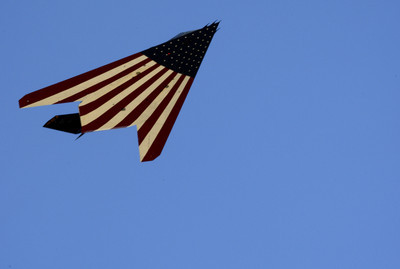Flying Into History
PALMDALE, Calif. -- Adorned with a specially painted U.S. flag on its belly, the first of the last four F-117A Nighthawk stealth warplanes roared overhead, drowning out cheers from the hundred or so spectators who gathered in a vacant lot to watch their final flight Tuesday near Lockheed Martin's Skunk Works plant.
At 1:59 p.m., the four-ship formation was bound for the Tonopah Test Range on the last leg of a retirement journey that began Monday at Holloman Air Force Base, N.M., and ended about an hour after Tuesday's takeoff at the place where the first stealth wing began more than 27 years ago.
A Lockheed spokeswoman confirmed the planes landed safely at the Tonopah airfield, which is inside the sprawling Nellis Air Force Base training range.
As retired Brig. Gen. Bill Lake put it during a morning send-off ceremony attended by some 5,000 on the tarmac outside the plant, they were going back to be mothballed in the "cocoons of the canyons at Tonopah."
The sight of the black jets leaving was a special moment for retired Skunk Works employee Phil Harris of Lancaster, Calif., as he watched the departure with his wife from the bed of their pickup.
"I never get tired of seeing it. It gives you chills," the 66-year-old former quality-assurance inspector said.
His wife, Bonnie, a retired secretary for Lockheed's Advanced Development Projects, summed up the experience. "It makes you whoop and holler," she said.
Col. Jack Forsythe, who piloted the lead plane, offered his thoughts on what he said will be the 50-plane fleet's last flight.
"It's just pretty humbling to be honest with you to represent not only Lockheed Martin but all the men and women that worked on this program in the Air Force throughout history," he said. "That part makes it overwhelming."
He said he doubts the $45 million planes ever will be taken out of mothballs in hangars at the Tonopah airfield, where they will be held in classified storage with their wings unbolted, five planes to a hangar.
"We always forget that when we talk big ideas about taking jets out of mothballs, you still need a pilot to fly them, and we've got the last group of pilots who have flown this aircraft operationally," he said. "And so these are the final flights."
The F-117A blazed the trail for today's air superiority stealth jet, the F-22 Raptor, which, with the F-35 Joint Strike Fighter, is replacing the Nighthawk.
Forsythe said the reason the worn-out planes were taken back to Tonopah instead of being put to bake in the sun at the Air Force's boneyard near Tucson, Ariz., is because "we don't want any competitors" from foreign nations stealing the stealth secrets.
The program was secret for eight years, he said.
"It was the nation's best-kept secret. Maybe the Manhattan Project was on par," he said, referring to the government's program to develop the atomic bomb during World War II.
Pat Burke, a design engineer and training instructor for Lockheed, worked on the project in its early years "up range," he said, at the Tonopah airfield from 1981 to 1984 while he lived in Las Vegas.
Those were secret times, he said. If someone asked him what he did, he would say, "I worked for Lockheed," and would leave it at that.
"If they had any questions, I told them to call the base and talk to the Lockheed rep who was out there. If they go beyond that, I told them I'd have to shoot them," he said.
Like many workers and former Lockheed workers at the send-off, he said he was saddened that the F-117As' operational days were over.
"I never thought I'd see this plane retired before I retired," he said. "Personally, I think it's a mistake, but I can understand where they're coming from."
Much of the success of the stealth technology can be attributed to Alan Brown, who worked in the mid-1970s as the deputy program manager for stealth research prototypes, dubbed "Have Blue," and to his boss Ben Rich, whom Brown described as the "father of the stealth."
"I was in charge of all the radar cross-section stuff," said Brown, 78, of Watsonville, Calif.
"When the Have Blue was very successful in test flights at Area 51, suddenly we're told, 'OK, can you make a military airplane? We'll give you a sole-source contract to make a military fighter-bomber.' And the Air Force insisted that I should be the program manager. The F-117 design was started in December '78."
Col. Jeffrey L. Harrigan, commander of the 49th Operations Group at Holloman, and Lake, the former wing commander, said the Nighthawk did its job from its first combat assignment in Panama in 1988 to its efforts in the Persian Gulf War in 1991 and in Operation Iraqi Freedom in 2003.
"Today we say farewell to a weapons system that has a history full of vision, guts, passion, heroism, defiance and incredible risk-taking," Harrigan said in a speech at the ceremony. "Clearly this weapon system has delivered for our nation, and we are safer for it."
Said Lake at the ceremony: "For over 20 years, we have defended America's freedoms with the Nighthawk. ... They have been deployed to Central America, the Pacific and the Middle East, sometimes in secrecy and sometimes in the spotlight.
"They have fought valiantly, and they have deterred aggression both by their very existence and by their mystique."
ON THE WEB Remembering the F-117A Last flight of the Stealth RELATED STORIES NELLIS AIR FORCE BASE: Retirement spurs memories Lockheed built 59 stealth fighters




















